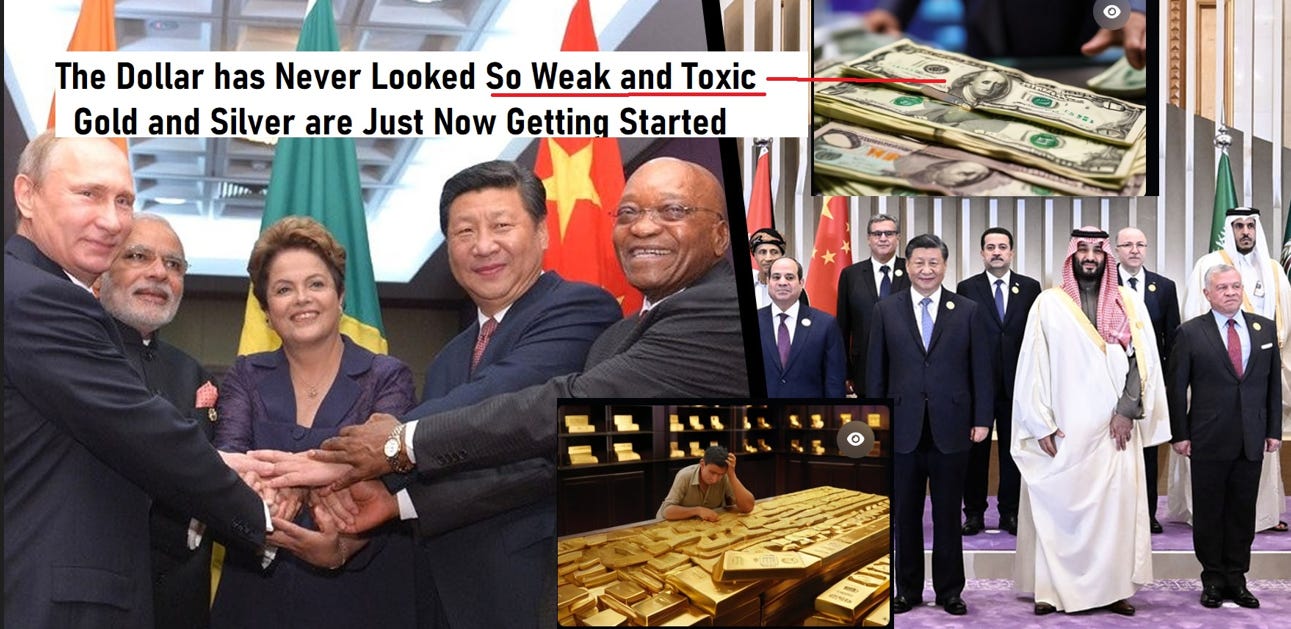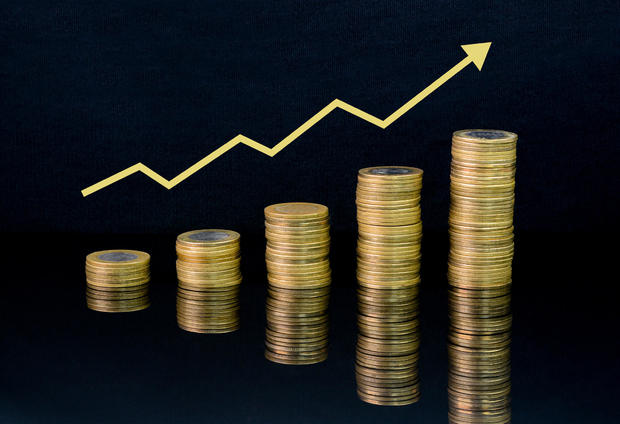Gold’s outlook for 2020
by Alasdair Macleod, GoldMoney:
 This article is an overview of the economic conditions that will drive the gold price in 2020 and beyond. The turn of the credit cycle, the effect on government deficits and how they are to be financed are addressed.
This article is an overview of the economic conditions that will drive the gold price in 2020 and beyond. The turn of the credit cycle, the effect on government deficits and how they are to be financed are addressed.
In the absence of foreign demand for new US Treasuries and of a rise in the savings rate the US budget deficit can only be financed by monetary inflation. This is bound to lead to higher bond yields as the dollar’s falling purchasing power accelerates due to the sheer quantity of new dollars entering circulation. The relationship between rising bond yields and the gold price is also discussed.
It may turn out that the recent extraordinary events on Comex, with the expansion of open interest failing to suppress the gold price, are an early recognition in some quarters of the US Government’s debt trap.
The strains leading to a crisis for fiat currencies are emerging into plain sight.

Introduction
In 2019, priced in dollars gold rose 18.3% and silver by 15.1%. Or rather, and this is the more relevant way of putting it, priced in gold the dollar fell 15.5% and in silver 13%. This is because the story of 2019, as it will be in 2020, was of the re-emergence of fiat currency debasement. Particularly in the last quarter, the Fed began aggressively injecting new money into a surprisingly illiquid banking system through repurchase agreements, whereby banks’ reserves at the Fed are credited with cash loaned in return for T-bills and coupon-bearing Treasuries as collateral. Furthermore, the ECB restarted quantitative easing in November, and the Bank of Japan stands ready to ease policy further “if the momentum towards its 2% inflation target comes under threat” (Kuroda – 26 December).
The Bank of Japan is still buying bonds, but at a pace which is expected to fall beneath redemptions of its existing holdings. Therefore, we enter 2020 with money supply being expanded by two, possibly all three of the major western central banks. Besides liquidity problems, the central bankers’ nightmare is the threat that the global economy will slide into recession, though no one will confess it openly because it would be an admission of policy failure. And policy makers are also terrified that if bankers get wind of a declining economy, they will withdraw loan facilities from businesses and make things much worse.
Of the latter concern central banks have good cause. A combination of the turn of the credit cycle towards its regular crisis phase and Trump’s tariff war has already hit international trade badly, with exporting economies such as Germany already in recession and important trade indicators, such as the Baltic dry index collapsing. No doubt, President Trump’s most recent announcement that a trade deal with China is ready for signing is driven by an understanding in some quarters of the White House that over trade policy, Trump is turning out to be the turkey who voted for Christmas. But we have heard this story several times before: a forthcoming agreement announced only to be scrapped or suspended at the last moment.
The subject which will begin to dominate monetary policy in 2020 is who will fund escalating government deficits. At the moment it is on few investors’ radar, but it is bound to dawn on markets that a growing budget deficit in America will be financed almost entirely by monetary inflation, a funding policy equally adopted in other jurisdictions. Furthermore, Christine Lagarde, the new ECB president, has stated her desire for the ECB’s quantitative easing to be extended from government financing to financing environmental projects as well.
2020 is shaping up to be the year that all pretence of respect for money’s role as a store of value is abandoned in favour of using it as a means of government funding without raising taxes. 2020 will then be the year when currencies begin to be visibly trashed in the hands of their long-suffering users.
Gold in the context of distorted markets
At the core of current market distortions is a combination of interest rate suppression and banking regulation. It is unnecessary to belabour the point about interest rates, because minimal and even negative rates have demonstrably failed to stimulate anything other than asset prices into bubble territory. But there is a woeful lack of appreciation about the general direction of monetary policy and where it is headed.
The stated intention is the opposite of reality, which is not to rescue the economy: while important, from a bureaucrat’s point of view that is not the greatest priority. It is to ensure that governments are never short of funds. Inflationary financing guarantees the government will always be able to spend, and government-licenced banks exist to ensure the government always has access to credit.
Unbeknown to the public, the government licences the banks to conduct their business in a way which for an unlicensed organisation is legally fraudulent. The banks create credit or through their participation in QE they facilitate the creation of base money out of thin air which is added to their reserves. It transfers wealth from unsuspecting members of the public to the government, crony capitalists, financial speculators and consumers living beyond their means. The government conspires with its macroeconomists to supress the evidence of rising prices by manipulating the inflation statistics. So successful has this scheme of deception been, that by fuelling GDP, monetary debasement is presented as economic growth, with very few in financial mainstream understanding the deceit.
The government monopoly of issuing money, and through their regulators controlling the expansion of credit, was bound to lead to progressively greater abuse of monetary trust. And now, in this last credit cycle, the consumer who is also the producer has had his income and savings so depleted by continuing monetary debasement that he can no longer generate the taxes to balance his government’s books later in the credit cycle.
The problem is not new. America has not had a budget surplus since 2001. The last credit cycle in the run up to the Lehman crisis did not deliver a budget surplus, nor has the current cycle. Instead, following the Lehman crisis we saw a marked acceleration of monetary inflation, and Figure 2 shows how dollar fiat money has expanded above its long-term trend since then.

In recent years, the Fed’s attempt to return to monetary normality by reducing its balance sheet has failed miserably. After a brief pause, the fiat money quantity has begun to grow at a pace not seen since the immediate aftermath of the Lehman crisis itself and is back in record territory. Figure 1 is updated to 1 November, since when FMQ will have increased even more.
In order to communicate effectively the background for the relationship between gold and fiat currencies in 2020 it is necessary to put the situation as plainly as possible. We enter the new decade with the highest levels of monetary ignorance imaginable. It is a systemic issue of not realising the emperor has no clothes. Consequently, markets have probably become more distorted than we have ever seen in the recorded history of money and credit, as widespread negative interest rates and negative-yielding bonds attest. In our attempt to divine the future, it leaves us with two problems: assessing when the tension between wishful thinking in financial markets and market reality will crash the system, and the degree of chaos that will ensue.
The timing is impossible to predict with certainty because we cannot know the future. But, if the characteristics of past credit cycles are a guide, it will be marked with a financial and systemic crisis in one or more large banks. Liquidity strains suggest that event is close, even within months and possibly weeks. If so, banks will be bailed, of that we can be certain. It will require central banks to create yet more money, additional to that required to finance escalating government budget deficits. Monetary chaos promises to be greater than anything seen heretofore, and it will engulf all western welfare-dependent economies and those that trade with them.
We have established that between keeping governments financed, bailing out banks and perhaps investing in renewable green energy, the issuance of new money in 2020 will in all probability be unprecedented, greater than anything seen so far. It will lead to a feature of the crisis, which may have already started, and that is an increase in borrowing costs forced by markets onto central banks and their governments. The yield on 10-year US Treasuries is already on the rise, as shown in Figure 3.

Assuming no significant increase in the rate of savings and despite all attempts to suppress the evidence, the acceleration in the rate of monetary inflation will eventually lead to runaway increases in the general level of prices measured in dollars. As Milton Friedman put it, inflation [of prices] is always and everywhere a monetary phenomenon.
Through QE, central banks believe they can contain the cost of government funding by setting rates. What they do not seem to realise is that while to a borrower interest is a cost to set against income, to a lender it reflects time-preference, which is the difference between current possession, in this case of cash dollars, and possession at a future date. Unless and until the Fed realises and addresses the time preference problem, the dollar will lose purchasing power. Not only will it be sold in the foreign exchanges, but depositors will move to minimise their balances and creditors their ownership of debt.
If, as it appears in Figure 3, dollar bond yields are beginning a rising trend, the inexorable pull of time preference is already beginning to apply and further rises in bond yields will imperil government financing. The Congressional Budget Office assumes the average interest rate on debt held by the public will be 2.5% for the next three years, and that net interest in fiscal 2020 will be $390bn, being about 38% of the projected deficit of $1,008bn. Combining the additional consequences for government finances of a recession with higher bond yields than the CBO expects will be disastrous.
Clearly, in these circumstances the Fed will do everything in its power to stop markets setting the cost of government borrowing. But we have been here before. The similarities between the situation for the dollar today and the deterioration of British government finances in the early to mid-1970s are remarkable. They resulted in multiple funding crises and an eventual bail-out from the IMF. Except today there can be no IMF bail-out for the US and the dollar, because the bailor gets its currency from the bailee.
Nearly fifty years ago, in the UK gold rose from under £15 per ounce in 1970 to £80 in December 1974. The peak of the credit cycle was at the end of 1971, when the 10-year gilt yield to maturity was 7%. By December 1974, the stock market had crashed, a banking crisis had followed, price inflation was well into double figures and the 10-year gilt yield to maturity had risen to over 16%.
History rhymes, as they say. But for historians the parallels between the outlook for the dollar and US Treasury funding costs at the beginning of 2020, and what transpired for the British economy following the Barbour boom of 1970-71 are too close to ignore. It is the same background for the relationship between gold and fiat currencies for 2020 and the few years that follow.
Gold and rising interest rates
Received investment wisdom is that rising interest rates are bad for the gold price, because gold has no yield. Yet experience repeatedly contradicts it. Anyone who remembers investing in UK gilts at a 7% yield in December 1971 only to see prices collapse to a yield of over 16%, while gold rose from under £15 to £80 to the ounce over the three years following should attest otherwise.
Part of the error is to believe that gold has no yield. This is only true of gold held as cash and for non-monetary usage. As money, it is loaned and borrowed, just like any other form of money. Monetary gold has its own time preference, as do government currencies. In the absence of state intervention, time preferences for gold and government currencies are set by their respective users, bearing in mind the characteristics special to each. It is not a subject for simple arbitrage, selling gold and buying government money to gain the interest differential, because the spread reflects important differences which cannot be ignored. It is like shorting Swiss francs and buying dollars in the belief there is no currency risk.
Loading...



